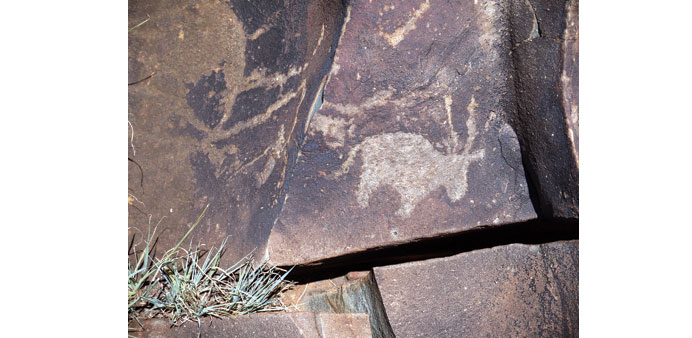A close-up of Bushmen art that has perplexed scientists for decades.
By Sinikka Tarvainen, DPA
Clarens, South Africa
Passing through a farm and following a path winding through a rocky and bushy landscape in South Africa, a visitor reaches a rock wall showing reddish and yellow images.
Human figures with animal heads stand next to a group of antelopes. A hunter takes aim at a rhebuck. Other paintings have faded into mere stains.
A stream purls by and sounds of birds fill the air as if no time had passed since the San - also known as Bushmen - made the images about 600 years ago.
The paintings behind Schaapplaats farm near the eastern town of Clarens form just one among an estimated 100,000 sites of rock art that the San - regarded as southern Africa’s first inhabitants and one of the oldest human groups - created across the region over millennia.
The paintings or engravings, the ages of which are estimated to range from 27,000 to 100 years old, are found in South Africa, Namibia, Botswana, Lesotho, Swaziland, Mozambique and Angola.
South Africa has more than 8,600 known sites. New ones keep being discovered and rock art expert Janette Deacon estimates that the total amounts to more than 25,000.
The paintings represent one of the oldest expressions of religious art, giving us clues into “where we come from as humans and our place in the universe,” says Siyakha Mguni, a rock art specialist at Johannesburg’s Witwatersrand University.
Less than 10% of the sites in southern Africa have been investigated, according to Mguni. As rain, sun, animals and human vandalism damage the paintings, researchers are racing against time to decipher their meaning.
The hunter-gatherer San were looked down upon and decimated by incoming Bantu populations and European colonialists for centuries.
Only about 100,000 of them remain in southern Africa, where they are now adopting a modern lifestyle and no longer paint on rock shelters, rocky outcrops or caves.
In earlier times, images were also made on smaller rocks lying out in the open. The location known as Wildebeest Kuil near Kimberley, for instance, has more than 200 engravings of an uncertain age bathing in the sun.
The rocks lying next to each other show elephants, rhinoceroses or antelopes - often stunningly beautiful - as well as symbols the meaning of which is not always known.
“San rock art is demonstrably no less complex, no less symbolic, than, say, Italian Renaissance art,” specialist David Lewis-Williams writes.
Long regarded as simple daubings of a primitive people, the rock paintings have only been investigated since the early 20th century and it was not until the 1980s that scientists cracked the code into their meaning.
“It was then understood that the rock art of the San was in the core of their religious beliefs and world view,” Mguni says.
Instead of having been made for decorative purposes or magic to help hunters catch their prey - as was first thought - the paintings show the world through the eyes of San shamans in trance.
Shamans metamorphose into animals to take on their power, encounter spirits and climb threads of light up to the sky. The paintings also show dances during which shamans touch people to heal them, as well as mythical animals believed to bring rain.
The surface of the rock was seen as a veil, the cracks leading the painter to an invisible world. The images were made with mineral paint containing blood - often from the eland, an antelope species sacred to the San - which was thought to emanate spiritual force.
Many of the images are still not understood, according to Mguni, who has now interpreted termite nests - constructions rising towards the sky - as symbolizing “God’s house.”
Many of the paintings will no doubt be lost before researchers find them. The ones that are known cannot be restored because “we don’t know exactly which materials the artists used” in each case, Mguni said.
The only hope of passing the paintings to future generations lies in copying them.
More than 3,000 of the rock art sites have been documented at the Witwatersrand Rock Art Institute. But painted copies, sketches or photographs are unable to convey large groups of images and the waviness of the rocky surface.
That can only be done with the latest technology, says Michelle Dye from the non-profit African Conservation Trust, which has used three-dimensional laser scanning to document 87 San rock art sites in the eastern Drakensberg mountains and nearby areas in cooperation with a local university.
High-precision scans of the rocky surfaces are combined with high-resolution photographs of the paintings to allow the spectator to enter a virtual copy of the site.
The African Conservation Trust and Witwatersrand have started putting such digital material online to make the millennia-old visions of San shamans accessible to the modern world.
“We would next like to try to digitally brighten up the colours of the images,” Dye said. “Our only problem is funding.”



